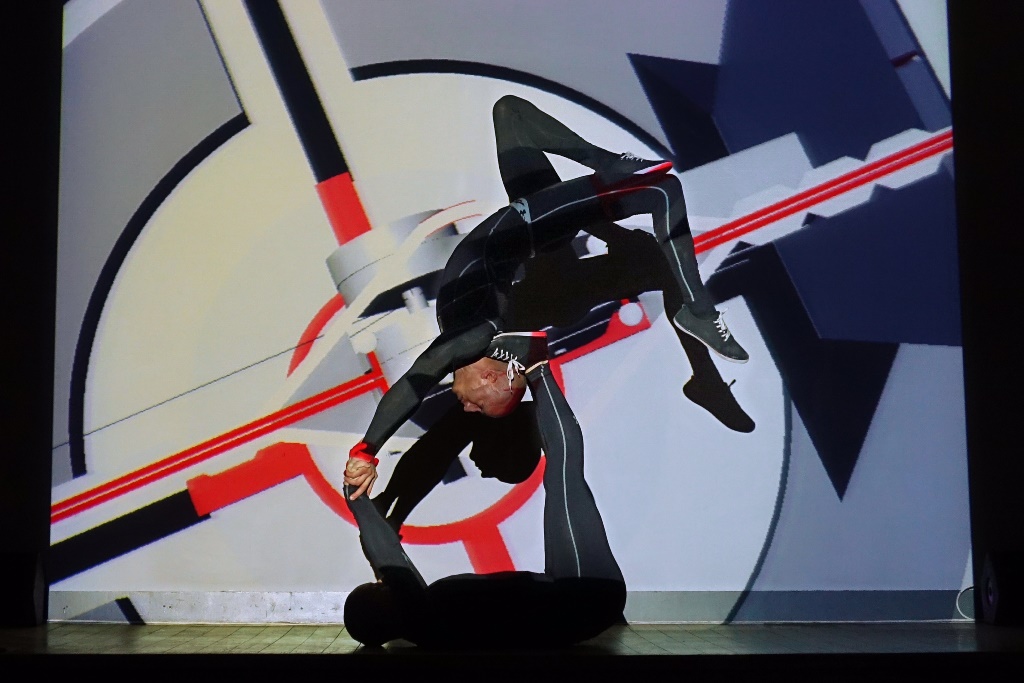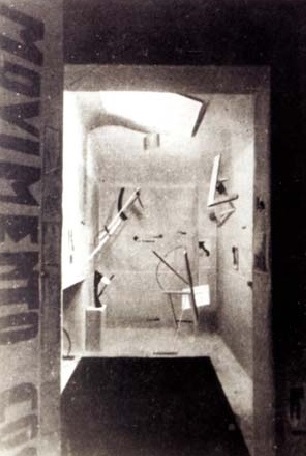postgravityart::aktuator
by dragan živadinov, dunja zupančič and miha turšič


a moment of the Informance action by postgravityart, 2016; the Constructivist Cabinet by Avgust Černigoj in Trieste, 1927
after the informance action the artists will be in conversation with Tatjana Rojc
POSTGRAVITYART is a term coined by a group of artists: Dragan Živadinov, Dunja Zupančič and Miha Turšič.
Noordung::1995-2045 premiered in 1995 in Ljubljana. The first repeatition, in 2005, was moved from the original stage to the model of the International Space Station (ISS) in the hydro laboratory at Star City (Russia). The second repeatition was performed in 2015 at KSEVT in Vitanje, the Cultural Centre of European Space Technologies that was opened in 2012 in Slovenia and operates at the intersection of artistic, scientific, cultural and space-related topics. In the remaining three decades, all fourteen actors will be replaced by technological substitutes which in turn will be placed in the Earth’s orbit at the end of the project. In 2045, during the fifth and last repeatition, Dragan Živadinov, co-founder of the Neue Slowenische Kunst, who is a candidate cosmonaut since 1998 (Yuri Gagarin Cosmonaut Training Centre, Star City), will use a spacecraft to convey 14 satellites/umbots into geostationary orbit, from where they will transmit signals to Earth and deep space. Now, inside its 50-year theatre project, Postgravityart is launching its first satellite Umbot::MG, that is a substitute for the actress Milena Grm, who passed away in 2011.
Just after their presentation of Informance, at the end of September, at the Moderna galerija in Ljubljana, in the frame of REPETITION/S Festival of Performance and Philosophy, a very interesting connection of this performance to the city of Trieste is the homage the artists tribute in it to the Italian-Slovenian artist Avgust Černigoj and his pioneering Constructivist Cabinet displayed in Trieste in 1927.
After the performance the artists will answer qustions put by the audience, moderator Ms Tatjana Rojc, literary critic.
Authors: Dunja Zupančič, Miha Turšič, Dragan Živadinov / Collaborators: Slavko Glamočanin, David Pilipovič, Aljoša Pirc, Jože Zajec / Special thanks: dr. Etienne Tilmans (ESA), Karen O’Flaherty (ESA) / Production: Zavod Delak / In cooperation with: ESA Redu Centre (B), ESTEC, Noordwijk (NL) / Support: Ministry of Culture Republic of Slovenia, City of Ljubljana, VO-KA.
Dragan Živadinov (SLO) is a theatre director from Ljubljana. He was a cofounder of the art movement Neue Slowenische Kunst in 1985. During the '80s he constructed the style “retro-gardism”. In 1983, he founded the retro-garde Theatre of Scipio Nasica's Sisters, and in 1987, the cosmokinetic observatory Red Pilot. In the early '90s, he constructed "informances" and transformed Red Pilot into the Noordung Cosmokinetic Cabinet. In 1995, he embarked on the 50-year theatrical process Noordung 1995-2045, through the style of "telecosmism." In 1998 he became a candidate cosmonaut, and in 1999 realised Biomechanics Noordung, the first complete theatre production in zero-gravity conditions. Since 2000, he has been constructing post-gravitational theatrical abstracts. In 2005 he staged Noordung 1995-2045 first reprise in Yuri Gagarin Cosmonaut Training Center, Star City, and in 2015 the second one in KSEVT, Vitanje.
Miha Turšič (SLO) was first involved into worldwide product and brand development. Since 2004 he is dedicated to the research of artistic methodologies and practices in outer space, developing post-gravity art and facilitation of space culturalisation. In his career he co-founded several institutions in the fields of research, development and art. He was a cofounder, and the director from 2010 until 2015, of the Cultural Centre of European Space Technologies (KSEVT) in Vitanje .
free admittance
info@triestecontemporanea.it
+39 040 639187